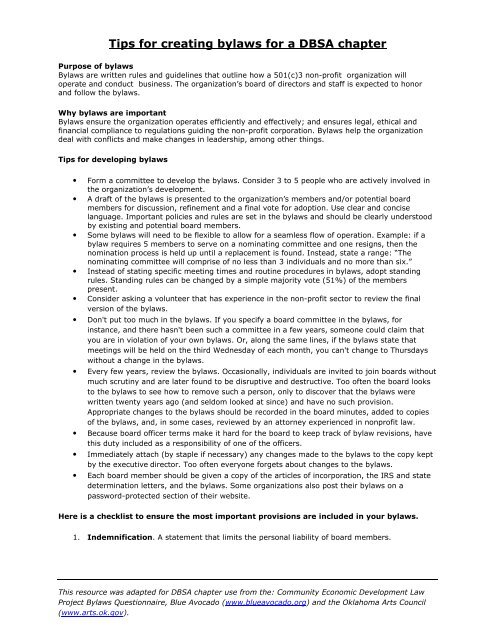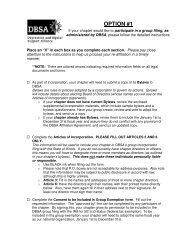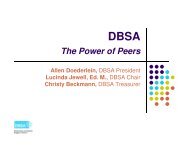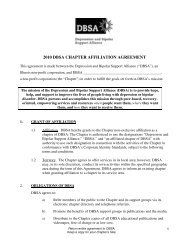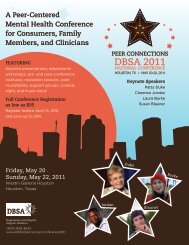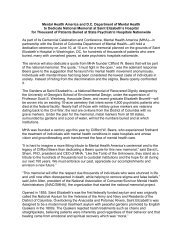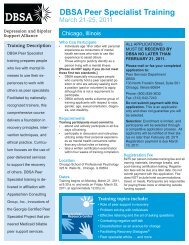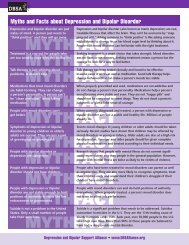Tips for creating bylaws for a DBSA chapter
Tips for creating bylaws for a DBSA chapter
Tips for creating bylaws for a DBSA chapter
You also want an ePaper? Increase the reach of your titles
YUMPU automatically turns print PDFs into web optimized ePapers that Google loves.
<strong>Tips</strong> <strong>for</strong> <strong>creating</strong> <strong>bylaws</strong> <strong>for</strong> a <strong>DBSA</strong> <strong>chapter</strong>Purpose of <strong>bylaws</strong>Bylaws are written rules and guidelines that outline how a 501(c)3 non-profit organization willoperate and conduct business. The organization’s board of directors and staff is expected to honorand follow the <strong>bylaws</strong>.Why <strong>bylaws</strong> are importantBylaws ensure the organization operates efficiently and effectively; and ensures legal, ethical andfinancial compliance to regulations guiding the non-profit corporation. Bylaws help the organizationdeal with conflicts and make changes in leadership, among other things.<strong>Tips</strong> <strong>for</strong> developing <strong>bylaws</strong>• Form a committee to develop the <strong>bylaws</strong>. Consider 3 to 5 people who are actively involved inthe organization’s development.• A draft of the <strong>bylaws</strong> is presented to the organization’s members and/or potential boardmembers <strong>for</strong> discussion, refinement and a final vote <strong>for</strong> adoption. Use clear and conciselanguage. Important policies and rules are set in the <strong>bylaws</strong> and should be clearly understoodby existing and potential board members.• Some <strong>bylaws</strong> will need to be flexible to allow <strong>for</strong> a seamless flow of operation. Example: if abylaw requires 5 members to serve on a nominating committee and one resigns, then thenomination process is held up until a replacement is found. Instead, state a range: “Thenominating committee will comprise of no less than 3 individuals and no more than six.”• Instead of stating specific meeting times and routine procedures in <strong>bylaws</strong>, adopt standingrules. Standing rules can be changed by a simple majority vote (51%) of the memberspresent.• Consider asking a volunteer that has experience in the non-profit sector to review the finalversion of the <strong>bylaws</strong>.• Don't put too much in the <strong>bylaws</strong>. If you specify a board committee in the <strong>bylaws</strong>, <strong>for</strong>instance, and there hasn't been such a committee in a few years, someone could claim thatyou are in violation of your own <strong>bylaws</strong>. Or, along the same lines, if the <strong>bylaws</strong> state thatmeetings will be held on the third Wednesday of each month, you can't change to Thursdayswithout a change in the <strong>bylaws</strong>.• Every few years, review the <strong>bylaws</strong>. Occasionally, individuals are invited to join boards withoutmuch scrutiny and are later found to be disruptive and destructive. Too often the board looksto the <strong>bylaws</strong> to see how to remove such a person, only to discover that the <strong>bylaws</strong> werewritten twenty years ago (and seldom looked at since) and have no such provision.Appropriate changes to the <strong>bylaws</strong> should be recorded in the board minutes, added to copiesof the <strong>bylaws</strong>, and, in some cases, reviewed by an attorney experienced in nonprofit law.• Because board officer terms make it hard <strong>for</strong> the board to keep track of bylaw revisions, havethis duty included as a responsibility of one of the officers.• Immediately attach (by staple if necessary) any changes made to the <strong>bylaws</strong> to the copy keptby the executive director. Too often everyone <strong>for</strong>gets about changes to the <strong>bylaws</strong>.• Each board member should be given a copy of the articles of incorporation, the IRS and statedetermination letters, and the <strong>bylaws</strong>. Some organizations also post their <strong>bylaws</strong> on apassword-protected section of their website.Here is a checklist to ensure the most important provisions are included in your <strong>bylaws</strong>.1. Indemnification. A statement that limits the personal liability of board members.This resource was adapted <strong>for</strong> <strong>DBSA</strong> <strong>chapter</strong> use from the: Community Economic Development LawProject Bylaws Questionnaire, Blue Avocado (www.blueavocado.org) and the Oklahoma Arts Council(www.arts.ok.gov).
12. How a committee may be created or dissolved.13. What committees exist, how members are appointed, and powers, if any. It may beeasiest not to specify committees in the <strong>bylaws</strong> at all; instead, permit the board to createand dissolve standing and temporary committees as it sees fit. As a result, the <strong>bylaws</strong> neednot be changed each time a committee is created or changed.14. Conference calls and electronic meetings. Example: votes by e-mail or web <strong>for</strong>um areprohibited. Meetings may be held by conference call if all members can simultaneously hearone another. As Internet usage grows, some boards are adding sections to the <strong>bylaws</strong> thatdescribe how to hold a board meeting on the Internet, or whether and how decisions can bemade by e-mail.15. When is the fiscal year? The fiscal year is the twelve- month accounting period <strong>for</strong> theorganization. It may be the calendar year, running from January 1 until December 31, orOctober 1 until September 30, or any other twelve- month period. However, in order to beincluded in <strong>DBSA</strong>’s group federal tax exemption, the <strong>chapter</strong>’s fiscal year must be January 1until December 31 st .Difference between Membership Organizations and Non-Membership OrganizationsIn a membership organization, the members have special rights and privileges that are established inthe <strong>bylaws</strong>.• In a membership organization the members may have voting rights and may elect the boardof directors.• In an organization without members new directors are elected or appointed by existingdirectors.A nonprofit organization may decide to be a membership organization because members help providea source of funding through membership dues or the members ability to raise funds <strong>for</strong> theorganization and reflect a broad base of support <strong>for</strong> the organization. Members may be part of thedecision-making process of the group and have voting rights or have special privileges but no votingrights, such as museum or theater memberships. If members have voting rights, the control of theorganization lies within its membership. Decision making is prolonged because a majority of themembers must come to agreement.Block clubs and groups that work to assist a particular industry or profession are frequently memberorganizations. Nonprofit corporations that provide direct services to a large segment of the populationtend not to be member organizations.If the organization is going to be a membership organization be<strong>for</strong>e drafting <strong>bylaws</strong> it should makedecisions about the following issues.1. Will members pay dues?1. How will the amount of dues be determined?2. How often will dues be paid? Annually, Quarterly, Semi- Annually3. Will members be removed <strong>for</strong> failure to pay dues?2. Will members nominate and elect the directors?3. How many members will be required to be present to transact business?The Illinois state statute allows a minimum of 10% of the members. Note that this allows asmall minority of the members of the organization to make decisions. It is recommended thata majority of the members must act.4. What are the requirements/qualifications <strong>for</strong> membership?This resource was adapted <strong>for</strong> <strong>DBSA</strong> <strong>chapter</strong> use from the: Community Economic Development LawProject Bylaws Questionnaire, Blue Avocado (www.blueavocado.org) and the Oklahoma Arts Council(www.arts.ok.gov).
Suggestions include: anyone who asks to join; anyone who asks to join and is voted in; oranyone who has a special relationship with your organization, representatives of specificorganizations, etc.5. Will there be more than one class of members?If your organization is made up of members representing very different interests, you maywant to establish special classes of members with different rights, including voting andnonvoting members. However, since this requires more record-keeping and makesorganizational matters more difficult, you must decide if this procedure is worth the time andef<strong>for</strong>t. Unless the by-laws state differently, each member is entitled to one vote on eachmatter submitted to a vote of members.6. How often should the members meet?A members meeting must meet at least annually. The <strong>bylaws</strong> may provide <strong>for</strong> greaterfrequency, however if the <strong>bylaws</strong> call <strong>for</strong> more meetings, the meetings must be held.7. Will members be allowed to call a special meeting? How many members must there be to calla special meeting?8. Will members be removed <strong>for</strong> cause?9. Will members be able to vote by proxy?This resource was adapted <strong>for</strong> <strong>DBSA</strong> <strong>chapter</strong> use from the: Community Economic Development LawProject Bylaws Questionnaire, Blue Avocado (www.blueavocado.org) and the Oklahoma Arts Council(www.arts.ok.gov).


